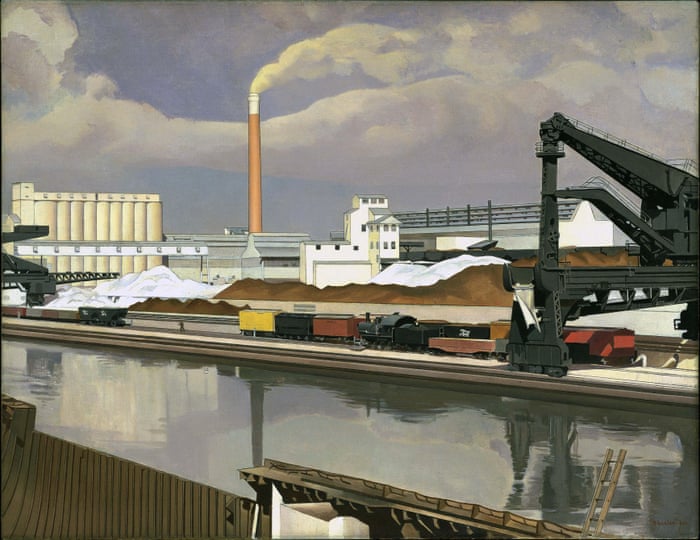
Charles Sheeler - American Landscape
Royal Academy, London
Dance marathons, dustbowl farms, brawling sailors, impoverished cotton-pickers … Adrian Searle takes a journey through 1930s America in a gripping show
Adrian Searle
The Guardian
Tuesday 21 February 2017
The sedan careers up the hill on a country road, slewing as a truck comes over the rise. We have a death’s-eye view, watching it happen. Everything slows down – a car pootling toward the sedan from behind, the oncoming truck going so fast its wheels have left the road. A storm is moving in, the fence-posts and telegraph poles, like ominous crosses on the hill, rearing.
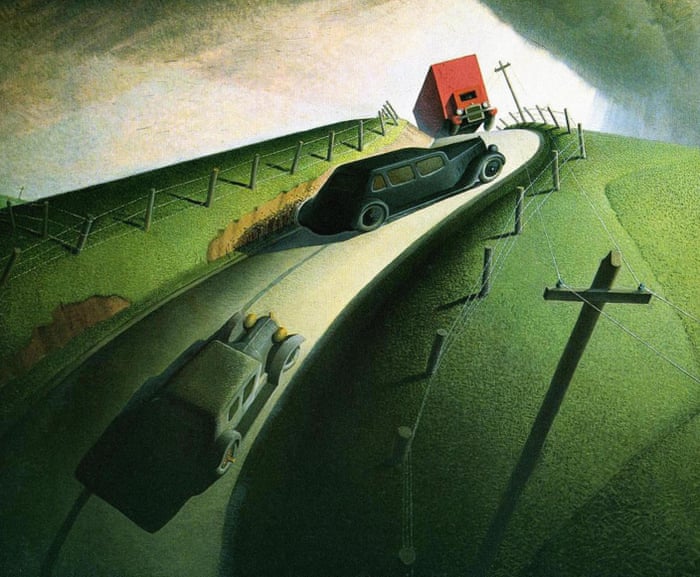
Grant Wood - Death on Ridge RoadTuesday 21 February 2017
The sedan careers up the hill on a country road, slewing as a truck comes over the rise. We have a death’s-eye view, watching it happen. Everything slows down – a car pootling toward the sedan from behind, the oncoming truck going so fast its wheels have left the road. A storm is moving in, the fence-posts and telegraph poles, like ominous crosses on the hill, rearing.

You don’t expect such graphic, cartoon action from Grant Wood, painter of ruralist, idealised farmsteads and small-minded Daughters of the American Revolution. The last time anything exciting happened was when Wood painted Paul Revere galloping through town and hollering, waking everyone up.
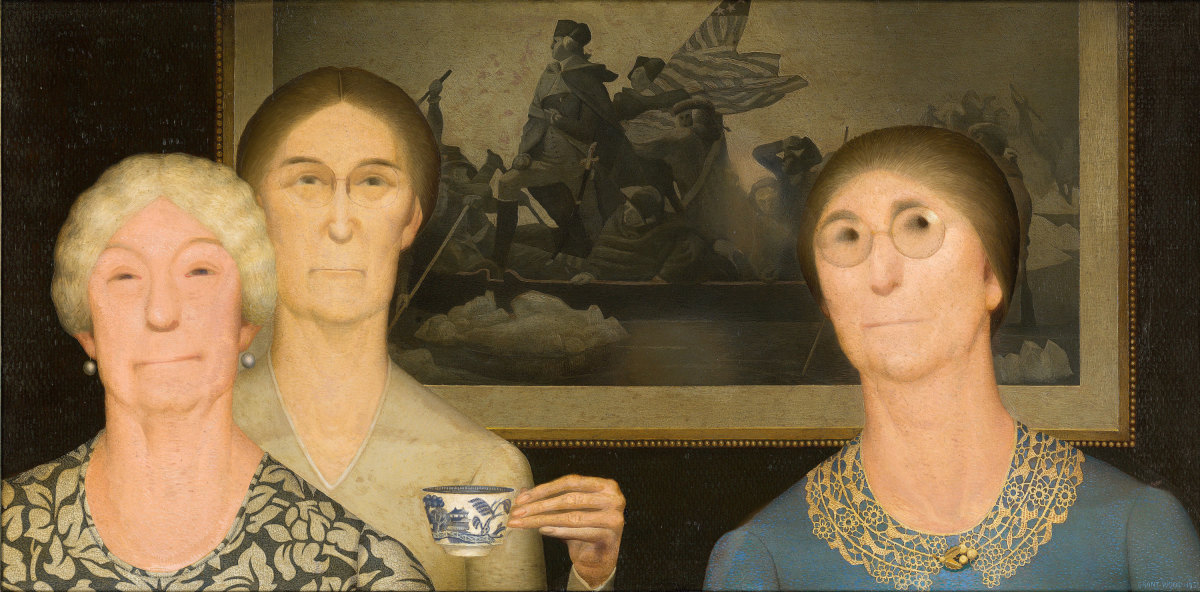
Grant Wood - Daughters of the Revolution
Curated by Judith A Barter of the Art Institute of Chicago, and drawn from many US collections, America After the Fall looks at American painting from the Wall Street crash and the great depression to the second world war. In no more than 50 paintings this fascinating show charts the turbulence of American society, its inequalities and divisions, its fears, fantasies and insecurities, during a period of both national and international upheaval. Sound familiar?
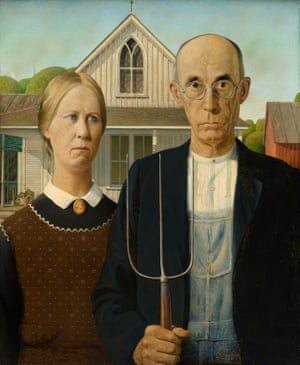
Grant Wood - American Gothic
Nothing happens in Wood’s best known painting, American Gothic, now in London for the first time, with that creepy couple standing in front of their farmhouse. The most you get here is a mean look and the shine on the sharpened tips of the old man’s pitchfork. Never mind that the woman in this enigmatic portrait of a suspicious, unfriendly farm couple were actually Wood’s sister and the artist’s dentist, a man doubtless well-acquainted with sharp tools.
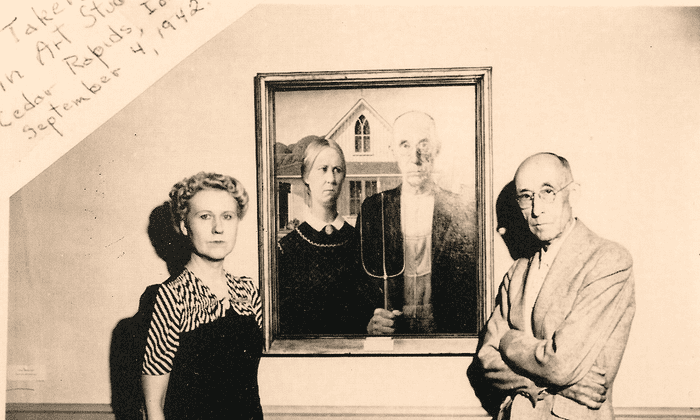
The artist’s models, Nan Wood Graham – his sister – and Byron McKeeby – his dentist – pose next to the painting
America in the 1930s was a society in turmoil and transition. The New Deal and public arts projects helped keep things going. New York went to the movies to watch films called Joys of the Flesh and Dangerous Curves, and the streets teemed with gawkers, barkers and floosies, street-walkers and drunks; Reginald Marsh’s paintings are filled with cheap fashions and cheaper thrills, cheap glamour and lots of clamour.
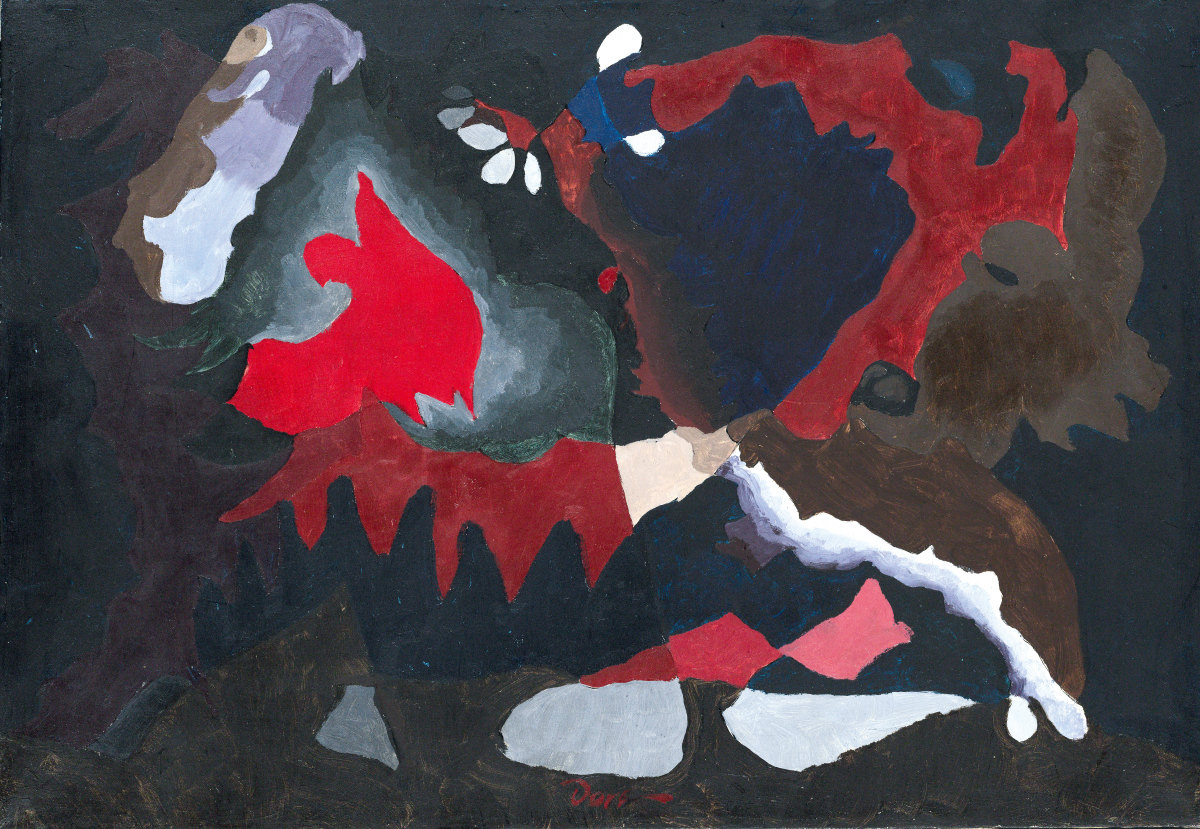
Arthur Dove - Swing Music (Louis Armstrong)
Exhausted dancers drag each other round the floor in Philip Evergood’s 1934 Dance Marathon, staying sentient for the chance of the $1,000 prize. The painting is as beat-up as the dancers.
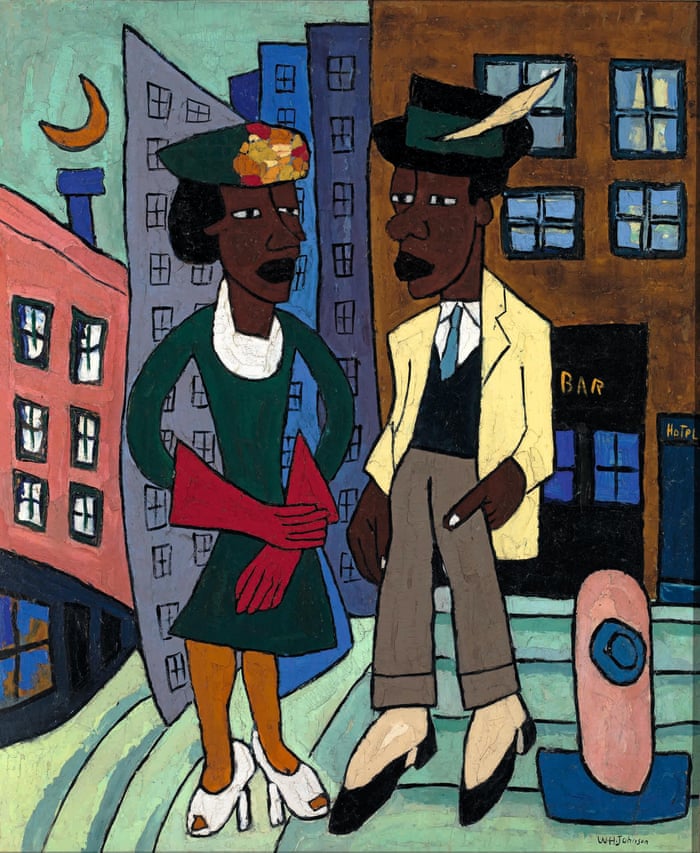
William H. Johnson - Street Life
In William H Johnson’s Street Life, a black Harlem couple are out for the evening under a clunky moon. The painting is all angles and buildings and the woman’s big red gloves and the electric evening.
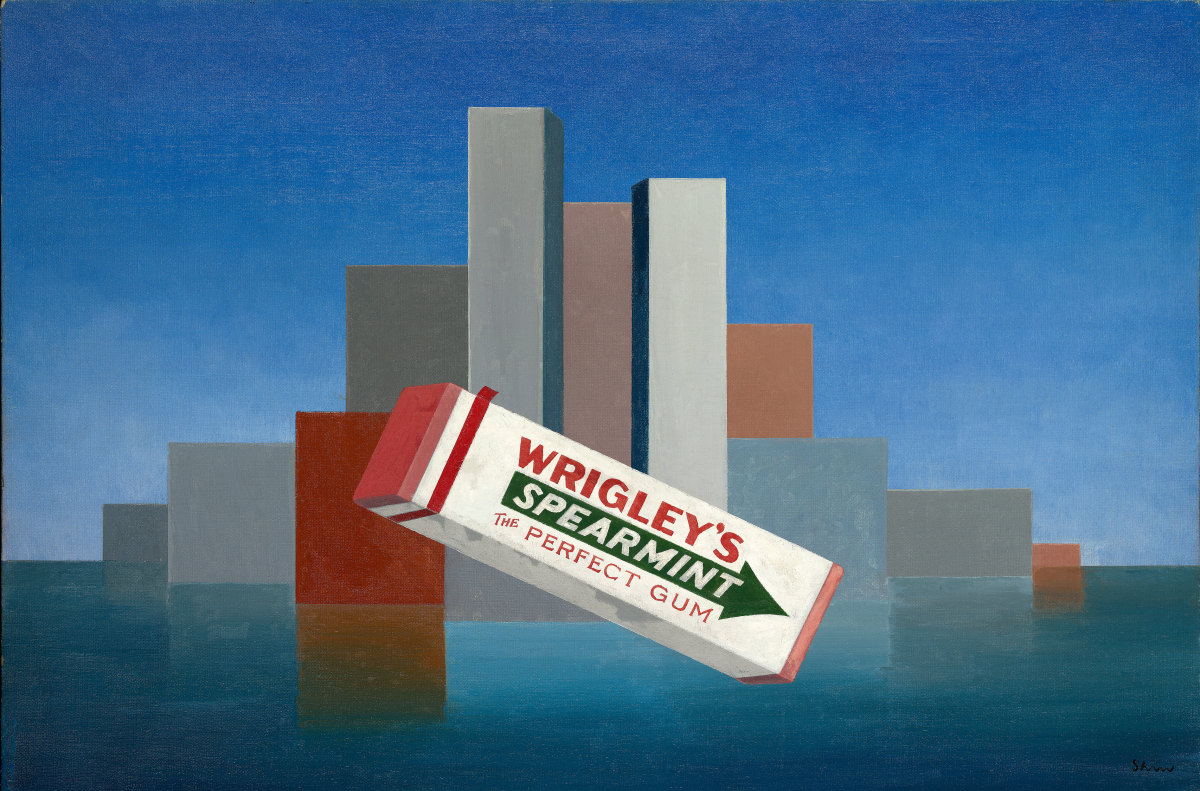
Charles Green Shaw - Wrigley's
It is the opposite of Charles Green Shaw’s suave geometric towers of the city overlain with a hovering, realistic pack of Wrigley’s gum. This is a city to chew on, an intimation of pop art and the future. Stuart Davis melded New York and Paris in a swanky modernism where new and old jostle amiably.
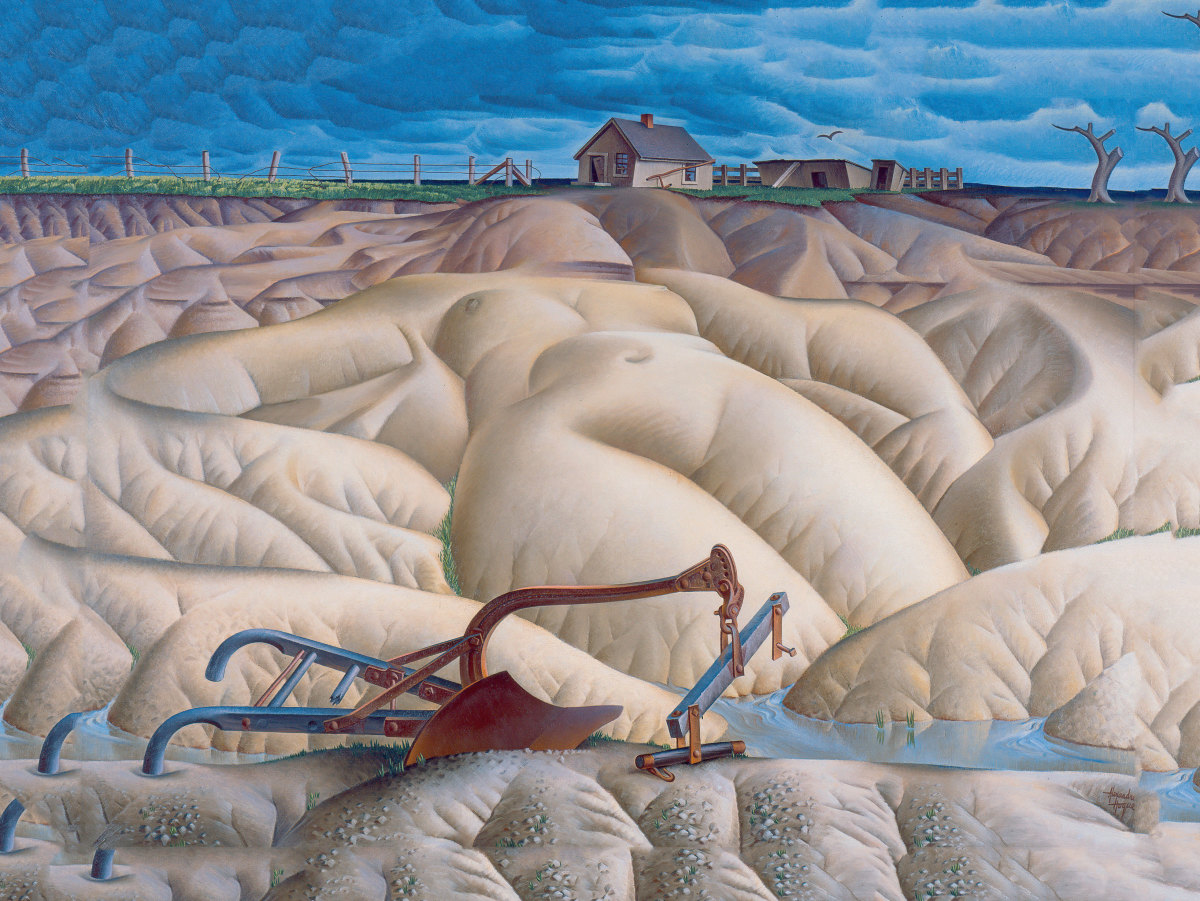
Alexandre Hogue - Erosion No. 2 - Mother Earth Laid Bare
Paul Cadmus started a scandal with The Fleet’s In!, a 1934 painting of sailors on the razz, drunk, bawling, sprawling and cruising with groups of good-time girls and an elegant gay man who offers a sailor a smoke. Thanks, pal. There are bulging crotches and asses, leers and slaps. The US Navy called the painting sordid and depraved. Now, it owns it. What fun this is.
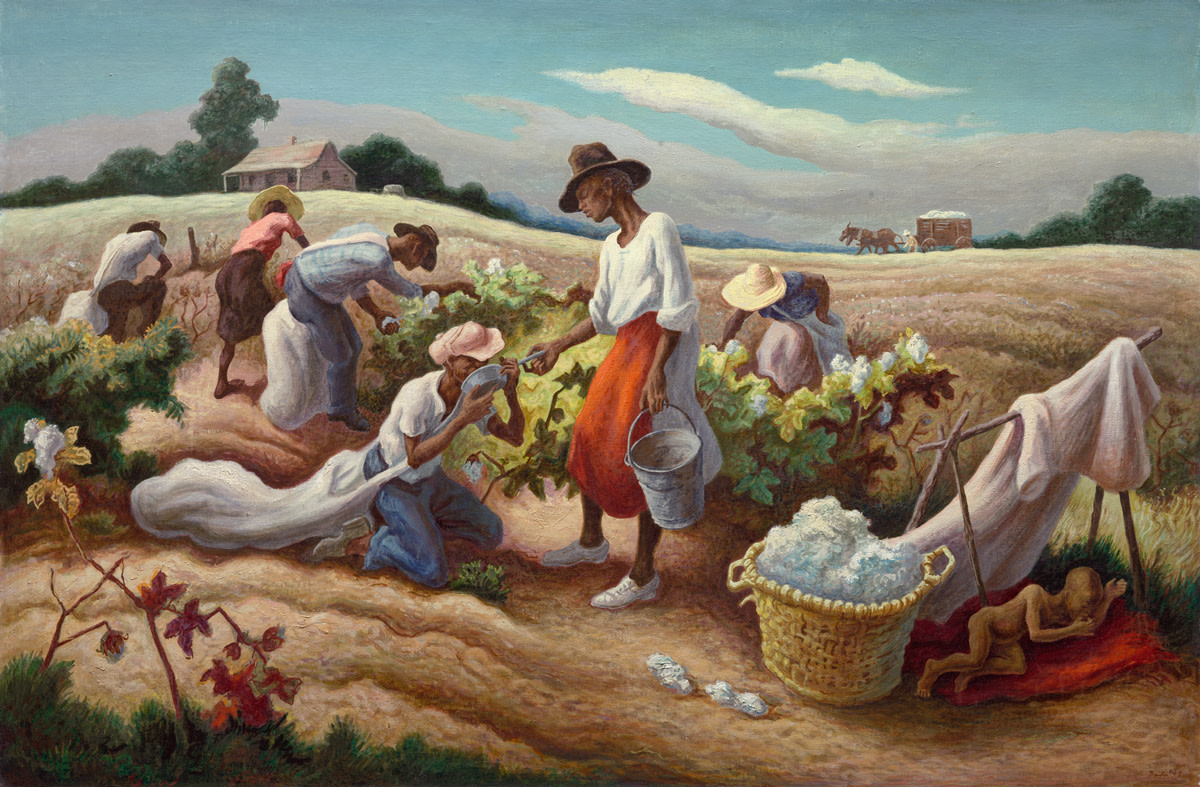
Thomas Hart Benton - Cotton Pickers
But this show takes sudden swerves. Cadus is a far cry from Joe Jones’s somnolent 1933 image of black roustabouts on a dock, heaving bails under the watchful gaze of a white, beer-gut boss, and Thomas Hart Benton’s impoverished Cotton Pickers, a sickly infant on the ground beside them, under the makeshift shade of a towel.

Georgia O' Keefe - Cow's Skull with Calico Roses
Homely, outdoor church suppers, Thanksgiving dinners prepared in steamy kitchens and nostalgic visions of a land of plenty compete with images of the earth farmed down to the bones, a world eroded. A hawk hovers over broken fences and collapsing barns in the dust bowl, the midwest prairie farms that overproduction and modern farming techniques inadvertently destroyed. In Alexandre Hogue’s rather obvious 1936 painting Mother Earth Laid Bare is a dead vista, the topsoil blown away, revealing a prone woman in humps of dust, a shifting dune.


Charles Green Shaw - Wrigley's
It is the opposite of Charles Green Shaw’s suave geometric towers of the city overlain with a hovering, realistic pack of Wrigley’s gum. This is a city to chew on, an intimation of pop art and the future. Stuart Davis melded New York and Paris in a swanky modernism where new and old jostle amiably.

Alexandre Hogue - Erosion No. 2 - Mother Earth Laid Bare
Paul Cadmus started a scandal with The Fleet’s In!, a 1934 painting of sailors on the razz, drunk, bawling, sprawling and cruising with groups of good-time girls and an elegant gay man who offers a sailor a smoke. Thanks, pal. There are bulging crotches and asses, leers and slaps. The US Navy called the painting sordid and depraved. Now, it owns it. What fun this is.

Thomas Hart Benton - Cotton Pickers
But this show takes sudden swerves. Cadus is a far cry from Joe Jones’s somnolent 1933 image of black roustabouts on a dock, heaving bails under the watchful gaze of a white, beer-gut boss, and Thomas Hart Benton’s impoverished Cotton Pickers, a sickly infant on the ground beside them, under the makeshift shade of a towel.

Georgia O' Keefe - Cow's Skull with Calico Roses
Homely, outdoor church suppers, Thanksgiving dinners prepared in steamy kitchens and nostalgic visions of a land of plenty compete with images of the earth farmed down to the bones, a world eroded. A hawk hovers over broken fences and collapsing barns in the dust bowl, the midwest prairie farms that overproduction and modern farming techniques inadvertently destroyed. In Alexandre Hogue’s rather obvious 1936 painting Mother Earth Laid Bare is a dead vista, the topsoil blown away, revealing a prone woman in humps of dust, a shifting dune.

Edward Hopper - Gas
America After the Fall is all the better for its rackety variety. Edward Hopper is here, and a lone Georgia O’Keefe skull painting, but there is much I have never seen before, telling the story of troubled times in a multitude of voices. Towards the end, a lone Jackson Pollock, an inverted self-portrait, looms among seething blooded limbs and fists and eyes. Here’s a house on fire, lit by the Ku Klux Klan, while a black girl lies dead in the foreground. A noose hangs from a branch and a dog howls. American Justice, by Joe Jones, needs no sublety.
Joe Jones - American Justice
Fascinating stories are attached to many of the works and artists here, for which you will need to buy the excellent catalogue to learn that the first owner of Wood’s car crash painting was songwriter Cole Porter, whose wife’s ex-husband was the first American to kill someone in an auto crash. That the black and white movie playing in Edward Hopper’s wonderful painting of a pensive, bored cinema usherette in the wings of the movie theatre is probably Frank Capra’s 1937 Lost Horizon, in which a plane crash in the Himalayas leads to the discovery of Shangri-La. The stories multiply.
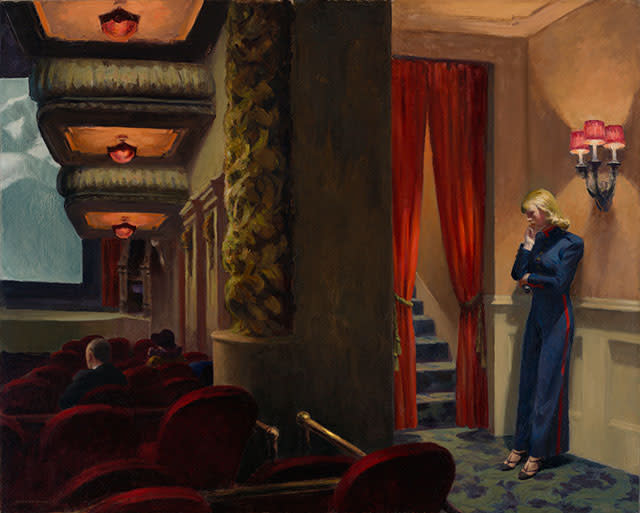
Edward Hopper - New York Movie
America in the 1930s was no lost utopia. While farming collapsed, industry was on the rise. Charles Demuth’s street corner – with its elegant stop lights, the facade of a tobacco factory rising into a sheer blue sky, the bulk of a water tower looming on the roof – manages to be both majestic, impersonal and empty. The title, And the Home of the Brave, taken from the new American anthem, gives us no idyll but a factory wall. It feels a lonely, silent place.
Emptier still were Charles Sheeler’s almost metaphysical industrial zones of river and railroad tracks, the cranes and vast factory complex of Ford’s River Rouge car plant. One lone, tiny figure walks the tracks. There’s no one else to be seen and the air is clear and still. The man is only there to give a measure of the place. Whatever is impending waits and the chimney belches.
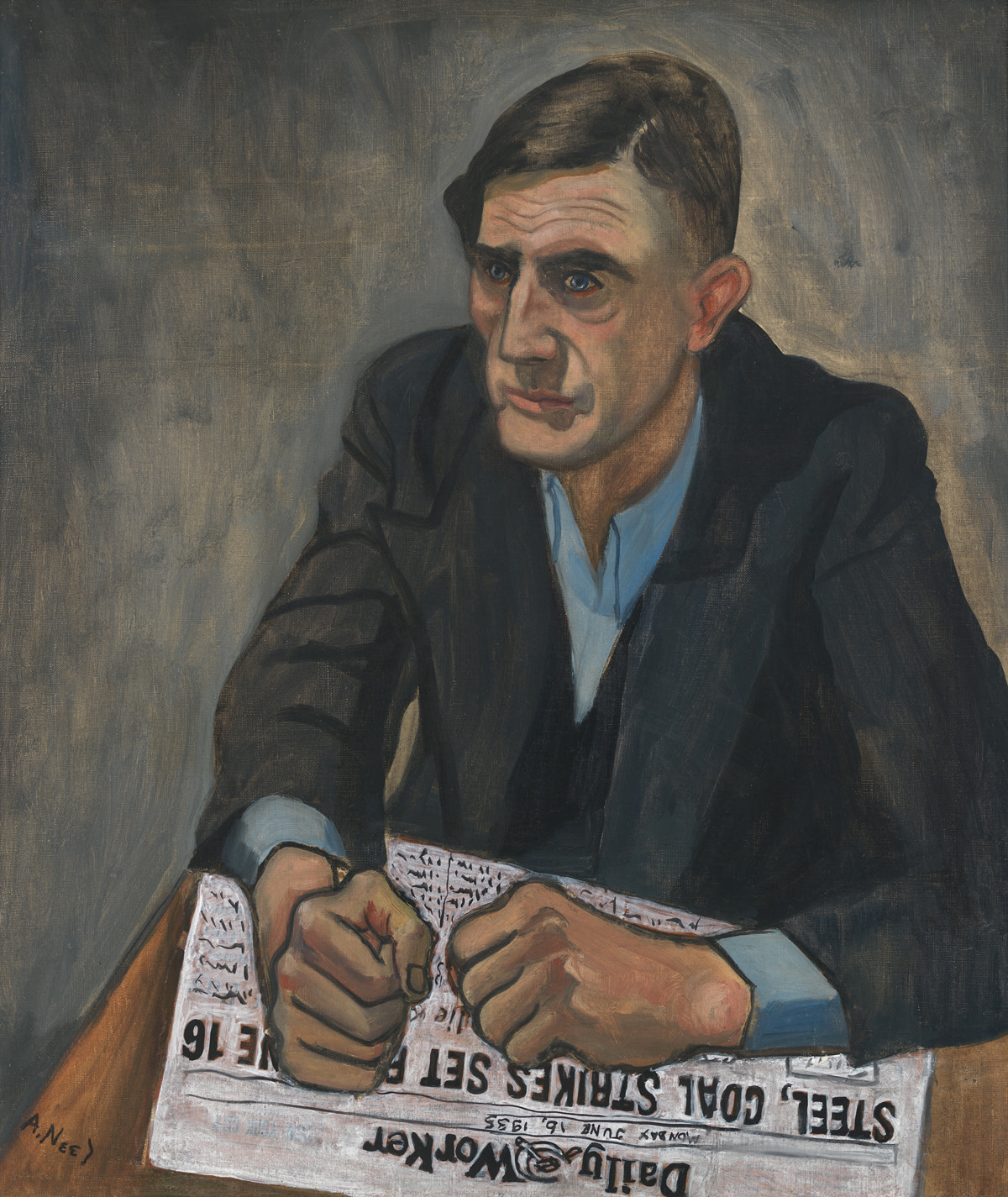
Alice Neel - Pat Whalen
There is terrific range in style and subject matter, outlook and temperament, artistic registers, ambitions and focus here. These are glimpses of the past, but one whose repercussions are felt in the divisions of America today. A terrific foil to the RA’s recently opened Revolution: Russian Art 1917-32 exhibition (whose time frame this show overlaps); and a rejoinder to the sprawling and unfocused Abstract Expressionism show that filled the main galleries last year, America After the Fall has other echoes of the present.
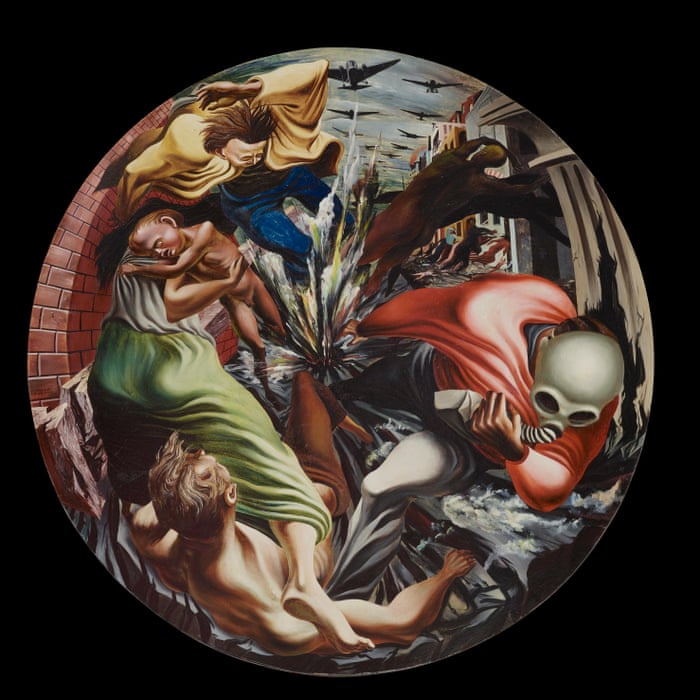
Philip Guston - Bombardment
Hankerings for a past that never was, a culture and certainty that was white, rural and stoic compete with images of black poverty, the aftermath of slavery, black aspiration and the threat of the KKK. Urban and rural America alike suffered the economic deprivations of the 1930s, in a land of crumbling certainties. A vexed relationship to Europe was exacerbated by the rumblings of war abroad. In 1938, O Louis Guglielmi painted Brooklyn Bridge as a blasted wreck, with a woman sitting on a twisted girder, an unexploded bomb protruding from her back. The year before Philip Guston painted the bombing of Guernica, in a tondo of mangled bodies, the German planes flying in.
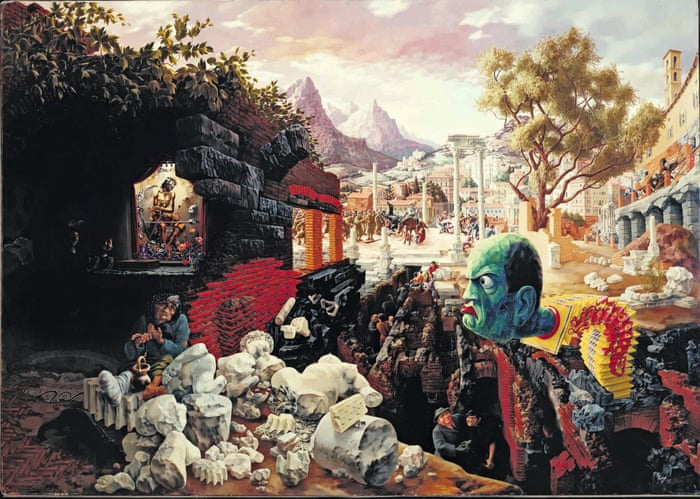
Peter Blume - Eternal City
Peter Blume, an artist who had spent time in Italy in the early 1930s, depicted the Roman Forum as a war zone, with blackshirts fighting the populace, conniving capitalists grinning from a trench, fleeing monks, a green-faced, red-lipped Mussolini as a glowering jack-in-the-box. He reminds me of someone else with a painted face. In a wayside shrine, Christ is surrounded by useless votives and baubles.
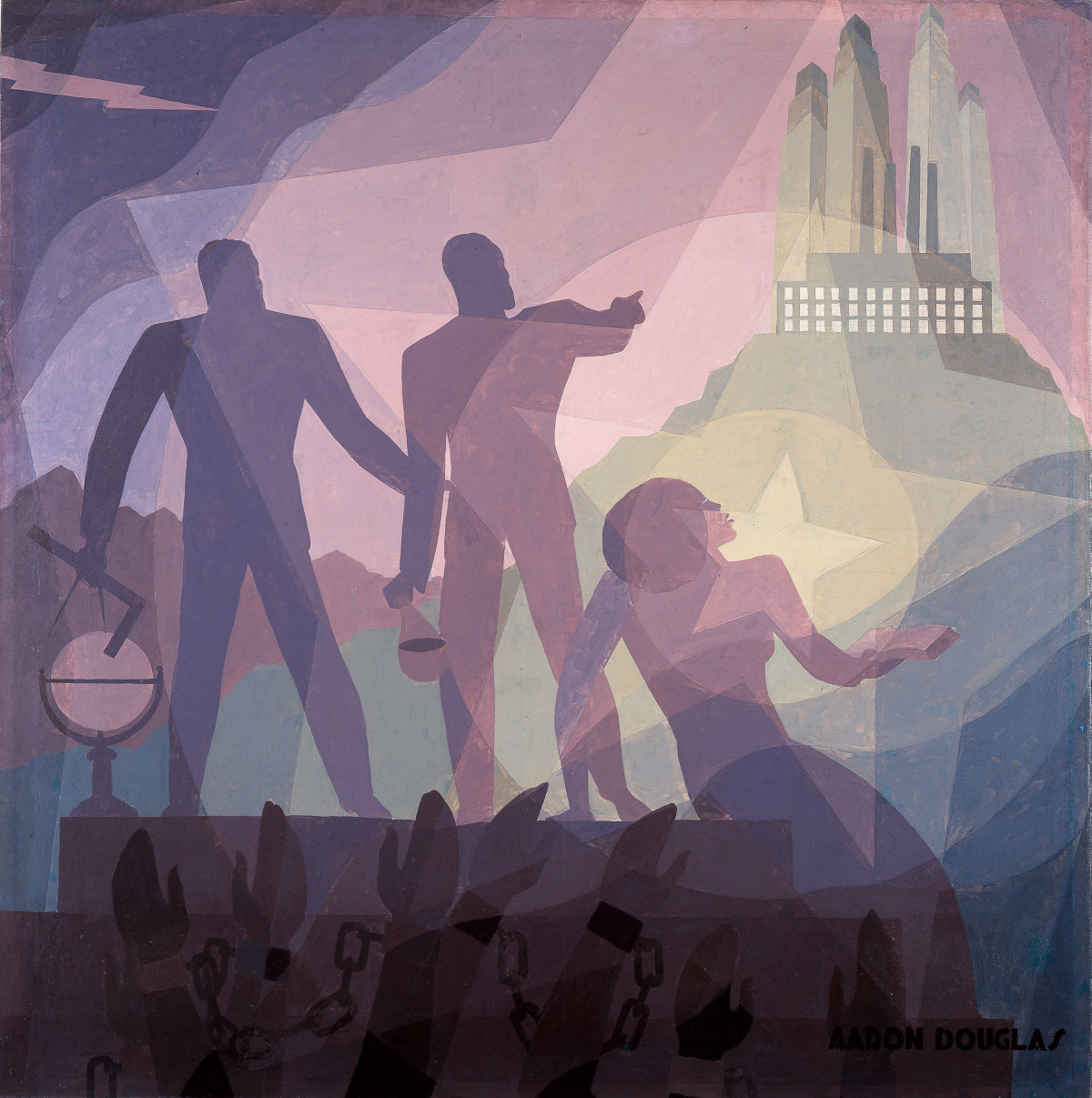
Aaron Douglas - Aspiration
While Blume was painting this, Sinclair Lewis published It Can’t Happen Here, about a presidential contender, Buzz Windrip, who beats Franklin Roosevelt and establishes a repressive dictatorship. Today’s echoes are obvious, the complexities still as enormous. What times.
America After the Fall: Painting in the 1930s is at the Royal Academy, London, from 25 February to 4 June









I have just been to see this exhibition. It is very interesting to see the different styles and certainly the iconic American Gothic is well worth a view. I was left feeling quite depressed which is not that surprising given the era. Certainly American Justice by Joe Jones has got to be one of the most disturbing paintings I have ever seen.
ReplyDelete